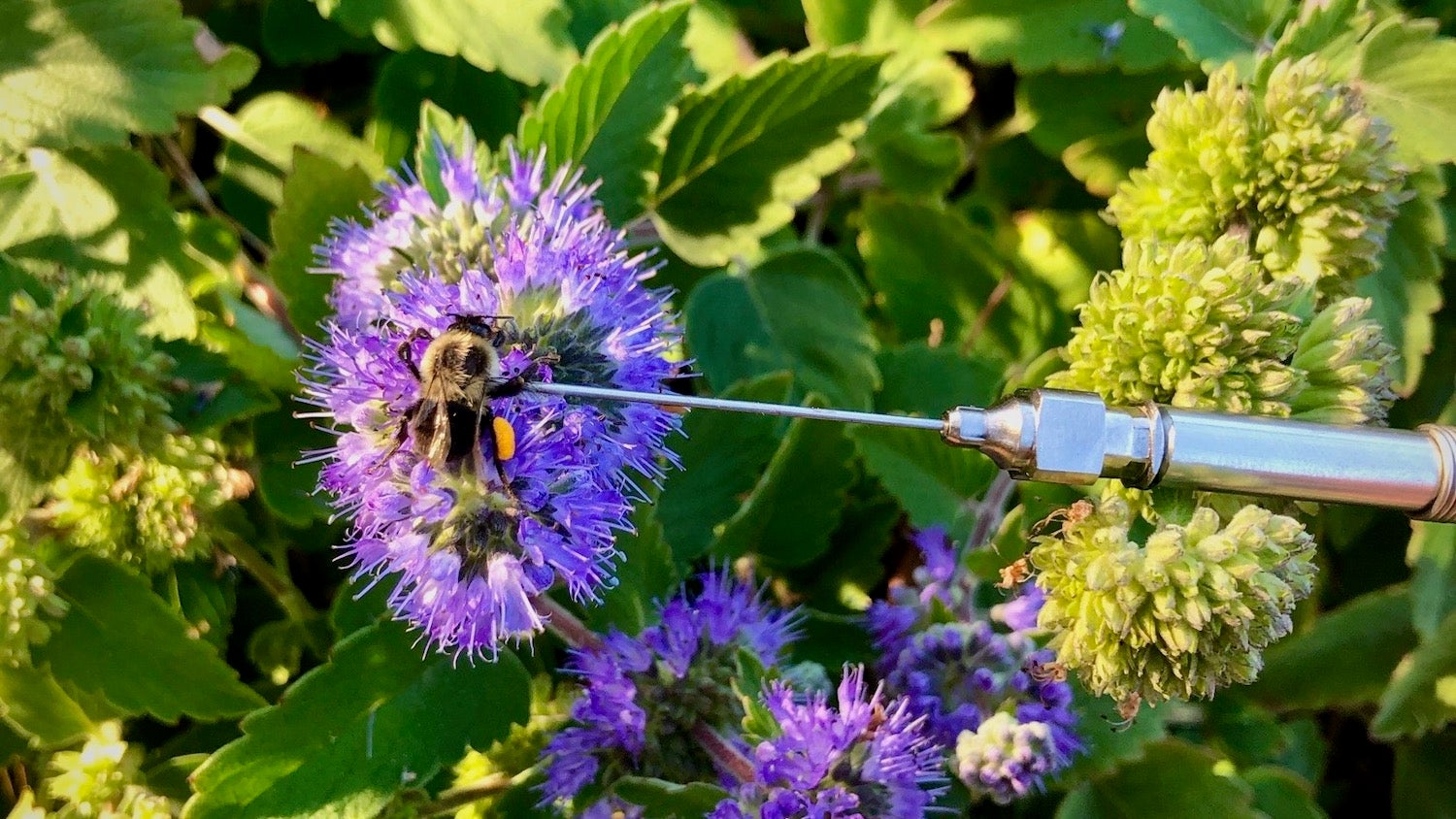Bumblebees are fuzzy, rotund, and indisputably adorable. They’re also secretly swole. The insects can cart around loads up to 80% of their body weight during foraging flights, and new research demonstrates that doing so probably isn’t easy.
The heavier a bumblebees’ pollen haul, the hotter a bee’s body temperature is likely to get, according to a study published Tuesday in the journal Biology Letters. As with most other animals, there’s a ceiling on how hot a bumbler can be before its body fails. Together with climate change, the thermal tax of lifting pollen could pose a threat to the important agricultural pollinators.
Though nectar is the staple bee food, if you’ve ever noticed that a bee seemed to be wearing tiny Cheetos as leg warmers, then you’ve seen a bee foraging for pollen. The buzzing insects collect the protein-rich flower powder in specially structured hind leg pollen baskets. Adult bees snack a little bit on the stuff, but mostly pollen goes to provisioning bee larvae so the next generation can grow up small and strong. It’s a critical component of any balanced bee diet, and bumblebees need to forage pollen to get all their required nutrients.
Yet filling up those pollen baskets and flying around with the cargo takes energy and creates heat (likely even more than nectar foraging does), as shown in the new research. Specifically, the scientists found that for every milligram of pollen carried, common eastern bumblebees (Bombus impatiens) get about 0.07 degrees Celsius hotter. On average, carrying pollen resulted in a 2 C increase in body temp across all of the 91 bees collected and analysed.
The researchers also established a thermal maximum for B. impatiens. In laboratory tests, they determined that the bumblebees seem to overheat between 41.3 and 48.4 C. Worryingly, the scientists often collected pollen-foraging bees with body temperatures within or approaching that threshold range. In other words: Those 2 degrees could easily be the difference between comfortable and too warm. Plus, the temperature tax of carrying pollen might make a crucial difference in the amount of foraging a bumblebee is able to perform on hot days.
The findings were a big surprise to study co-author Elsa Youngsteadt, an entomologist at North Carolina State University. Initially, when an undergraduate researcher in her lab (and her eventual co-author) Malia Naumchik suggested that bee pollen loads could be big enough to impact body temperature, Youngsteadt was sceptical. “I was like, ‘I’m not sure that we’d be able to pick up that signal,’” she told Gizmodo in a phone call. But Youngsteadt opted to support Naumchik, now a biology master’s student at Montana State University, in pursuing the idea, and the resulting data proved her first impulse incorrect. “I was floored by how clear of a signal it was,” the entomologist said.
To come to their conclusions, Naumchik and Youngsteadt trapped individual bumblebees that were actively foraging pollen. Immediately upon capture, each bee got stuffed into a tube-like contraption called a “bee squeezer” and had its temperature taken with a thin probe. From there, the researchers euthanised the bees, collected the pollen loads, and weighed the pollen and bee bodies separately.
As a baseline, the researchers didn’t want to just collect ambient temperature data but rather a more bee-specific data point. So, they stuck a dead bee on a temperature probe to keep continual tabs on a relevant thermal reading. “It’s perfectly controlled for the objectives of the study,” John Hranitz, a biologist at Bloomsburg University in Pennsylvania who was not involved in the new research, told Gizmodo in a phone call. “The study is well done and very complete.”

People often think of bees as cold-blooded animals whose temperatures are influenced solely by the environment, both Naumchik and Youngsteadt said. But actually, the complex insects are thought to control their body temperature in a few different ways. For instance, bees can rest in the shade or spit up nectar in order to get evaporative cooling going. Bee temp is a product of behaviour and many of other variables.
The new data supports that pollen weight is one of those factors. A couple of past lab-based studies had already suggested that nectar foraging could make bees warmer and boost their metabolic rates. This research extends that knowledge to pollen and shows that the trend holds true even in the wild.
To compensate for the hot and heavy burden that pollen poses, the bees are likely making adjustments when it’s warm outside. “They’re making trade-offs,” said Hranitz. For individual bees, carrying pollen isn’t “a death sentence or anything,” Naumchik said. “Our study isn’t saying that all bees are going to die… they have a lot of ways to adapt, and they probably will adapt.”
Maybe bees carry less pollen or work more slowly on steamy afternoons. Maybe bumblers will spend more time selecting flowers in the shade and avoid available food in the sun as the climate warms. Maybe, when it’s too hot, the bumblebees will simply opt to stay in their nests. Such shifts probably won’t cause immediate and obvious harm to individuals. Ultimately, though, those theoretical alterations are bound to impact the hive. Less pollen means less food for larvae and potentially fewer bees next year.
Bumblebee populations and ranges are already in decline. It’s a problem for the insects and also for the future of the plants they pollinate and human agriculture. Tomatoes, cucumbers, squash, and more are all often the product of a bumblebee’s efforts.
Previous research suggests that direct impacts of rising temperatures, more frequent extreme weather, habitat destruction, and pesticide use all play a role in bumblebee losses. But the interplay of climate change and pollen foraging could be yet another part of the explanation. “It’s one of several potential stressors that bumblebees are facing,” said Naumchik. “This might be just one piece of the puzzle.” Bumblebees may be super strong, yet everything — even an insect power lifter — has its limits.
